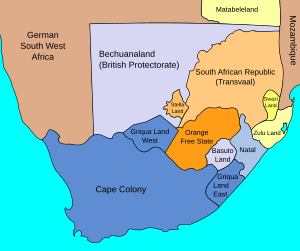Bechuanaland facts for kids

Bechuanaland was a large area in southern Africa that was protected by Great Britain. Today, this land is known as the country of Botswana. Britain started protecting Bechuanaland in 1885. They did this to help the local people against groups called the Boer Republics, who were also trying to control land in the region.
Bechuanaland was a very big place, covering about 582,000 square kilometers (which is about 225,000 square miles). This is roughly the size of France! Interestingly, its main city, or capital, was not even inside Bechuanaland itself. The capital was a city called Mafeking (now known as Mahikeng), which was in South Africa.
Contents
What Was a Protectorate?
A protectorate is a bit like a country that has a big brother looking out for it. In this case, Britain was the "big brother" for Bechuanaland. This meant Britain helped manage the area's defense and foreign affairs. However, the local leaders and people still had a lot of control over their own daily lives and traditions.
Britain offered this protection mainly to stop other European powers, like Germany, from taking over the land. It also helped to prevent conflicts with the Boer Republics, who were Dutch-speaking settlers in South Africa.
Why Was the Capital Outside the Territory?
It might seem strange that Bechuanaland's capital was in another country. Mafeking was chosen because it was a good central spot. It was also easier for the British to manage things from a town that was already well-developed and connected. This setup allowed the British to keep an eye on the region without fully taking over the local customs and ways of life within Bechuanaland itself.
Life in Bechuanaland
Life in Bechuanaland under British protection was mostly peaceful. The local people, mainly the Tswana ethnic groups, continued their traditional ways of life. They farmed, raised cattle, and lived in their communities. The British mostly focused on keeping peace and managing trade routes. They did not interfere much with the daily lives of the people.
Over time, the British helped to set up some basic services. These included schools and health clinics. However, development was slow compared to other British colonies. The focus was more on maintaining stability than on rapid change.
Becoming Botswana
As the years passed, many African countries started to gain their independence. The people of Bechuanaland also began to ask for more control over their own future. Leaders like Seretse Khama played a big role in this movement.
In 1966, Bechuanaland finally became an independent country. It was renamed Botswana. Seretse Khama became its first president. Botswana has since become a successful and stable country in Africa. It is known for its diamond mines and its commitment to democracy.
Images for kids
-
An 1887 map showing the Crown colony of Bechuanaland (shaded pink) and the Bechuanaland Protectorate (pink border). This was prior to the extension northward to include Ngamiland in 1890.
-
Stamp with a portrait of Queen Elizabeth II, 1953
See also
 In Spanish: Bechuanalandia para niños
In Spanish: Bechuanalandia para niños



